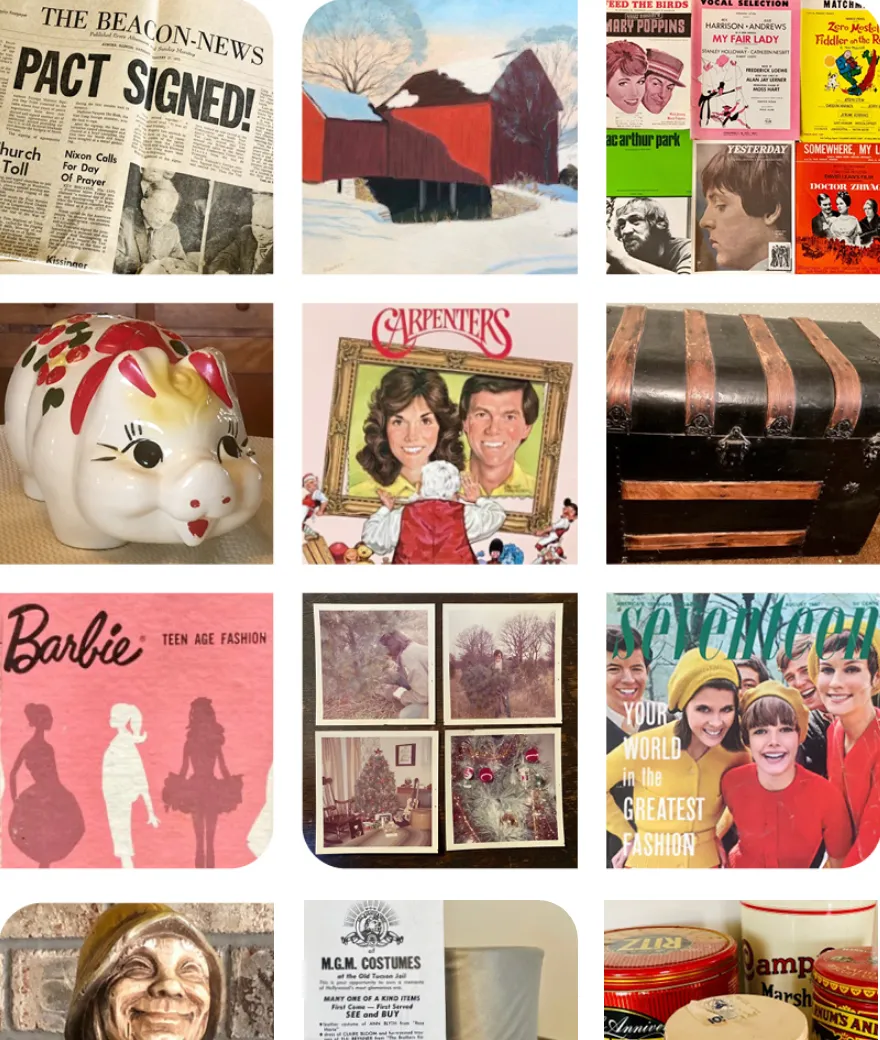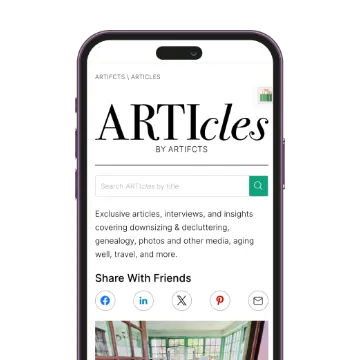Earlier this year we called out on social media for a genealogist who was interested in collaborating with us to see if our co-founder Ellen was in fact related to a global superstar.

Guess who the mystery superstar was? Lady Gaga!
This potential connection seriously confused Ellen, who asked, “Isn’t she Italian!?” whereas her family has a mix of Luxembourgian, German, French, and English heritage. It turns out Lady Gaga was a case of an over eager auto correct in a text message from Ellen’s genealogist aunt. The message should have read Lady Gage, with an “e,” as in the wife of Thomas Wentworth Gage, a commander-in-chief, North America, during the early days of the American Revolution. Granted, Lady Gage is still in impressive ancestor, but she somehow lacks the awe power of Lady Gaga.
We met with our volunteer, Jill Browne, Founder of Clutter School (@MessyNestDeclutterCoach on IG), and discussed exploring other family history instead, potentially through what, with a bit of latitude, could become ancestral Artifcts.
Today we’re sharing the highlights with you, Artifcts style, as Family History Month ends, and we all settle in for a long winter’s nap, aka the holiday season with our family where family lore and history are born and shared. Seize the moment. Use these Artifcts as inspiration as you ask for details, sift through old family photos, and maybe even take home an heirloom or two, and Artifct That!
Over to you, Jill!
An Uncommon Ancestry Approach to Artifcts
I love the concept of Artifcts. To me Artifcts offers an opportunity to create a digital museum of whatever one wants to preserve.
As a geographer, I am fascinated by the immovable parts of our histories: landscapes, buildings, towns, roads, statues, and so on. As a genealogist, I can't resist a good cemetery, too. As Winston Churchill said, "We shape our buildings, and afterwards our buildings shape us." He was talking about the Commons Chamber in the UK Houses of Parliament, but the same thing applies to our homes and to the shapes of our cities and towns. Buildings and cultural landscapes show us what we think is important in the part of the world we occupy.
This collection of Artifcts includes only one portable object, and it’s not in Ellen’s family's possession. It's in a museum and probably most people in her family have no idea it exists.
But with this one object, we can all appreciate how a single artifact can become a significant piece of family history to dozens, even hundreds of people with the passage of time. After all, you probably don’t even know your third cousins, and yet you share the same 2X great-grandparents. If any family heirlooms that belonged to those distant great-grandparents still exist, most likely you and your third cousins, their descendants, have no idea, or, if you do, have lost the history behind them.
This is one reason why I love the intersection of genealogy and Artifcts, and it’s also my defence of Artifcting things you don't actually own. It gives people a chance to share and to discover parts of their family's history that basic genealogy doesn't usually include.
Now, let’s check out this Artifcts collection!
The Artifcts
Out of the many possible objects and stories tied to Ellen’s May (maternal) and Bowker (paternal) heritage, here are the ones I chose for Ellen’s ancestral deep dive:
-
-
- a piece of WWI trench art,
- two cemeteries,
- a town,
- a homestead, and
- a national historic site.
Artifct #1: First World War Trench Art engraved "Leut AH Yorton"
The Artifct preview below shows a piece trench art, in this case a decorated artillery shell. The etching indicates France, May 21, 1918, A. H. Yorton. It commemorates the day Andrew Yorton entered the trenches with Wisconsin’s 127th Infantry. As this article from the Lewis Army Museum points out, it's not known whether Andrew created this piece himself or commissioned the work, but the article does offer amazing details of Andrew's service during WWI.

Trench art engraved "A. H. Yorton", illustration in "An Introduction to Trench Art: The Story of AH Yorton," Allie Krisko, "Virtual Exhibits," Lewis Army Museum, Joint Base Lewis-McChord, Washington, photograph on website (
https://lewisarmymuseum.com/virtual-exhibits: accessed 23 October 2024).
And who is Andrew to Ellen?
Andrew Henry “Hank” Yorton (1886-1959) was Ellen’s second great-uncle, the elder brother of Ellen’s great-grandmother, Rena Yorton Wilson (1888-1965). In January 1906, Rena married Glidden Wilson, the very man who bought the family harp that Ellen has often referenced and shared here.
From a family history point of view, the story here is that Ellen’s great-grandmother and all the rest of her brother Andrew's family had to endure the long wait while he was away in France, never knowing if he would return. He sailed for France on February 18, 1918, and while the war officially ended on November 11, 1918, he didn’t leave France until December 10, 1918.
The US observes Veterans Day, and Canada Remembrance Day, every November 11th, making this shell a fitting Artifct to share and reshare this time of year.
Artifct #2: Two cemeteries in Aurora, Kane County, Illinois
Can a cemetery be an Artifct? In my book, yes! Cemeteries are pieces of our heritage that connect families to their past. As physical places, they create a tiny dot on the map where we can say, yes, this is part of me. I would be especially likely to keep a cemetery as an Artifct if it had several generations of my ancestors. I don't have that, but Ellen does, and then some!
In fact, Ellen’s maternal family ancestry converges in Aurora: If Ellen were to look at just this one geographic area, she would find the impact of multiple ancestral families.
The Marywood Cemetery in Aurora has the graves for Ellen’s May and other ancestors going back in a nearly unbroken line to their very arrival in the US.
The Calvary Cemetery has the graves and memorials for the original May family immigrant parents, Johann Petur May (1799-1861) and his wife Anna Knapp May (1794-1857), who were from Luxembourg. Their son, Nikolaus May (1838-1909), buried in Marywood, was also born in Luxembourg. He emigrated with his parents and at least some of his siblings in 1856.
The May parents died within a few years of their arrival, but their son Nikolaus, continued to live in Aurora, where he married Eva Kellen (1842-1910). Eva, while born in Germany, had a father who was native to Luxembourg as well. That’s why it’s unsurprising to see Luxembourg feature prominently in Ellen’s maternal side DNA profile.

Artifct #3: The Town of Clockville, New York
Clockville also gets my vote for another unconventional family history Artifct. It has a known connection to not one but two families in Ellen’s family tree (Yorton and Lamoreux). In addition, Clockville is so small, that if Ellen were to visit, no matter where she’d venture in Clockville, she’d probably be retracing her ancestors' footsteps.
Remember Ellen’s great-grandmother Rena Yorton from our Artifct above about the trench art? She descended from Paul Yorton (1793-1871) and among her siblings was a brother, Hank, who was born in Clockville, New York. This is just a hamlet, but in its cemetery, you will find their dad Paul, Ellen’s 4X great-grandfather.
It’s through Rena’s brothers that the connection the Lamoreux family is made: Hank married Electa Lamoreux, and George married Electa's sister, Elizabeth Jane. This connection between the Yorton and Lamoreux families persisted as a number of them migrated west from Clockville to Wisconsin, where Ellen grew up. The “Old Lamoreux place” near Ashland, Wisconsin, is well known and Hank’s and Electa’s son Morris lived there at the end of his life.
BONUS TIDBIT: When you’re conducting genealogy research you often find threads you don’t have time to pull in the moment. This is one of those threads and too good not to share. Previous research by Ellen’s aunt traces the Yortons back to the Netherlands and Germany, although some other members of Ancestry.com may have found different lineages than her aunt, including a potential family association with the Dutch East India Company in Cape Town. That may be valid or completely fanciful. More research for another day!
If Ellen were to visit [Clockville], no matter where she’d venture, she’d probably be retracing her ancestors' footsteps.
Artifct #4: Castle Garden Emigrant Depot
Castle Garden deserves an Artifct if for no other reason than to dissuade you from potentially thinking of Ellis Island as THE point of entry for immigrants to the US. Not so fast!
It’s understandable that many people associate Ellis Island with the immigration of their families, as many immigrants to the USA did pass through the famed location.
But "about 20% of Americans can trace their ancestry to someone who went through [the earlier arrival station] Castle Garden,” according to the US National Park Service. Ellen’s May ancestors immigrated to the US in 1856, which would have put them in the right time frame to be processed at Castle Garden.
Artifct #5: Bowker homestead, Shabbona, Illinois
For the 5th and final Artifct, we’re switching gears for a peek into the paternal (Bowker) side of Ellen’s family to place them on the map (wink, wink) before we close out this genealogical Artifct exploration.
On March 16, 1849, Daniel Bowker bought 160 acres of land from James Jack, a Private in the Army who was given a Military Warrant for the land. Here is a copy of the transfer document dated December 20, 1850.

The land is close to Shabbonna's Grove, named for Chief Shabbonna, a Potawatomi Chief and notable figure in the history of the area. Here is a map of Shabbonna Township, DeKalb County, Illinois from 1860, with Daniel Bowker's name on the south-west quarter of section 12.

Lamb, Daniel W,
Map of DeKalb County, Illinois (Philadelphia: Daniel W. Lamb, 1860), enlargement showing D Bowker's land (SW 1/4 of section 12, Shabonna Township); image,
Library of Congress (
https://www.loc.gov/resource/g4103d.la000110/?r=0.306,0.82,0.288,0.127,0 : accessed 16 Oct 2024).
You can see how the area looks today – wide open farmland – on Google street and satellite view.
Genealogy and Artifcts
These are the sort of Artifcts that genealogy and family history research can turn up, with only a taste of the finer details left in to give you a feel for how genealogists go about the telling of family history. But for most people, it’s not about the historical facts and dates but the key themes, stories, and connections behind these discoveries that matter most. And have no doubt, there are loads of more conventional artifacts hanging out in Ellen’s tree should she go looking to Artifct them, too – census records, photographs, drawings, certificates of birth, marriage, and death, and so on.
Artifcts is a wonderful place for keeping and sharing memories. The five Artifcts I've shared are about recovering memories, recognizing the connections, and discovering and sharing the stories and doing so in a way that resonates through the generations. I hope they inspire you to preserve and share your own family history discoveries, traditional or otherwise, too.
Happy Artifcting!
Jill
Enjoy all things family history? Take a look back at these ARTIcles, too.
DIY Family History Book: Publish Your Artifcts with Akin
An Easier and More Personal Approach to Family History
Use Artifcts Timelines to Enrich Your Family History
10 Ways Genealogists are Using Artifcts That May Help You, Too
How to Artifct Family History and Heirlooms
###
© 2024 Artifcts, Inc. All Rights Reserved.




































